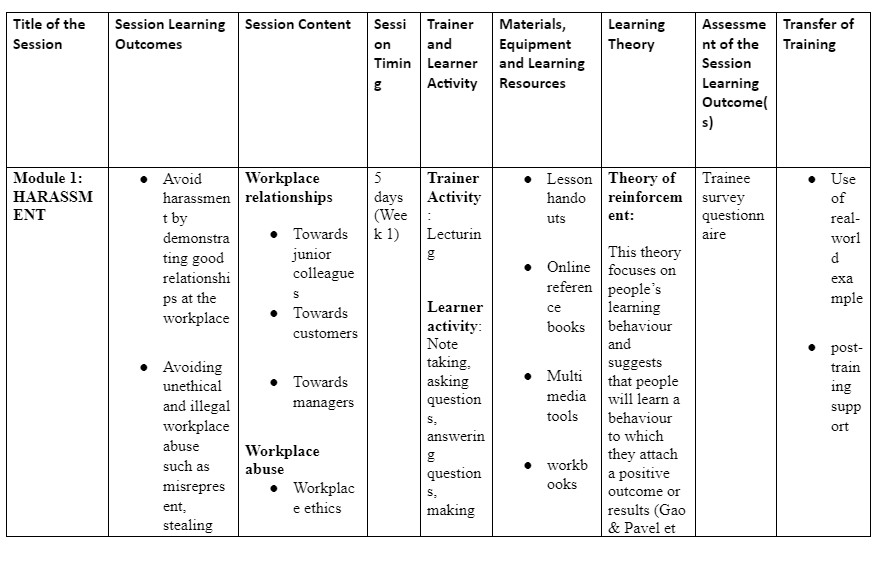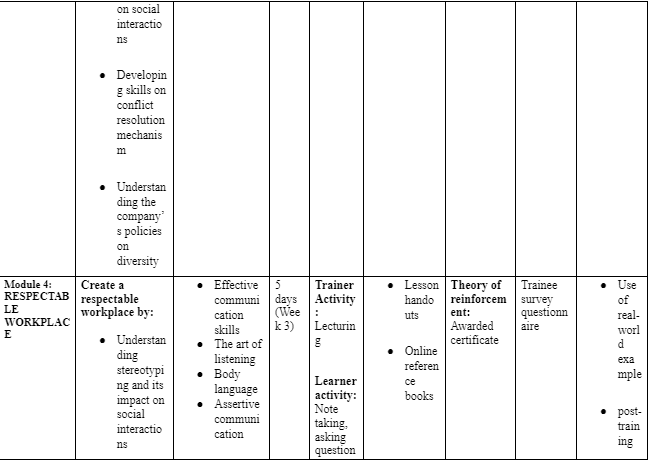Workplace Training to Foster Inclusivity and Respect
- 16 Pages
- Published On: 11-12-2023
Executive Summary
Racial discrimination lawsuits are detrimental to company names and destroy the reputation of big companies, regardless of the years they have spent inbuilding those reputations. This essay presents a project proposal to roll out a staff training on racial discrimination at the workplace. The project follows a lawsuit filed by 40 employees against a hypothetical company, where thy accuse their supervisors over racial slurs and harassment. The four-week training intervention will be delivered online and will cover a range of topics including workplace relationship, abuse in the workplace, results of workplace abuse, response to workplace abuse, diversity and maintaining a respectable workplace, and HRM dissertation help. workplace abuse, results of workplace abuse, response to workplace abuse, diversity and maintaining a respectable workplace.
Introduction
This essay elaborates a project proposal for employee training on discrimination and harassment at the workplace. The hypothetical organization has come under fire recently when 40 black women sued the company over racial discrimination. The women claimed that the company supervisor, Jane (not her real name) called them racial slurs such as ‘Lazy blacks’, ‘monkey’, and N-word. Through the lawsuit, the women also alleged that Jane denied them medical attention and bathroom, breaks and fired others based on their racial orientation. Moreover, the women sued the company over the allegation that higher ranks of the management were aware of Jane’s inappropriate discrimination against them and failed to take any action.
Needs assessment
Having identified that the organization was facing a significant issue of racial slurs and harassment, the HR suggested a needs assessment project to identify whether systemic racism was a major problem worth the management’s attention. Against this backdrop, a needs assessment was conducted in three major steps namely: conducting a gap analysis, identifying priorities of importance identifying causes of racism, and lastly, identifying solutions to the problem. The following section describes these steps in detail:

Gap analysis
This step involved checking the current performance of the organization against organizational goals and values. It was necessary to determine the current state of staff interaction and social cohesion to identify whether they coincide with the organizational value of inclusivity and diversity. This was done through a focus group interview that gathered both departmental managers (or supervisors) and employees working under them. The discussion revealed serious gaps in employee cohesiveness and social interaction that needed to be addressed.
Considering the legal mandate of the organization to shun any form of racial discrimination, a decision was made by the company leadership to move into the next step of the need’s assessment, which is to identify the expected performance requirements against racial discrimination. As recommended by Kiburz et al (2017), this involved asking the question: are the supervisors doing a good job in shunning racial discrimination? Do they know how to avoid racial discrimination in their lines of duty? Upon realising that the supervisors were not doing a good job in avoiding racial discrimination and that they did not have the necessary skills to avoid racial discrimination in their lines of duty, a decision was made to train them on how to avoid racial discrimination. Thus, training was identified as the organizational development solution to the problem of racial slurs and discrimination.
Overview of the training intervention
Having identified the issue of racial discrimination among supervisors, the management decided to launch an online training intervention for all supervisors. The online training can help achieve the desired level of employee inclusivity and diversity while accommodating the fact that the company generally operates in a virtual scattered workplace (Slutsky et al, 2019). That said, some of the topics that will be tackled in the training include workplace relationship, workplace abuse, results of workplace abuse, response to workplace abuse, diversity and maintaining a respectable workplace. The training will be delivered by a human resource consultant team with an experience in training and mentoring employees on workplace discrimination and racial issues. The consultant was selected due to their expertise in this area, and their ability deliver value at a relatively cheaper price than what the company would spend without outsourcing. Take a deeper dive into Training and Development in HR with our additional resources.
Target population
The training intervention will be targeted at all the supervisors working in the company’s 54 branches. The supervisors work on a tight schedule that would not enable them to attend a face-to-face training. Therefore, online training was considered the best option, bearing in mind that time and location would be the greatest limitation for the training project; for both the leaners and the instructors who may not be available on time for a face-to face instruction. By removing the face to face requirement, any supervisor will be able to participate from a location and time that suits them.
Learning outcomes
After completing the training, each supervisor will be able to:
- Avoid harassment by demonstrating good relationships at the workplace towards their junior staff, towards their customers, managers; by avoiding unethical and illegal workplace abuse such as misrepresent, stealing from colleagues, giving falsifying records, gossip, sexually harassing co-workers and drug abuse
- Develop an understanding for workplace diversity including the meaning of diversity, diversity facts and figures in the UK, how to harness diverse cultural differences and their impacts on social interactions, conflict resolution mechanisms, understanding company’s policies on diversity.
- Understand stereotyping and its impact on social interactions
- Appreciate the need for a respectable workplace through effective communication skills
- Develop the art of listening, the use of assertive communication and how to get along better with difficult staffs.
- Demonstrate an understanding of personal differences and how to be accommodative to people from diverse cultures and backgrounds
- Apply responsible behaviour in solving employee conflict and complaints
Planned evaluation strategies
Through out the training, the consultants are expected to maintain contact with the trainees and work with the managers to evaluate the trainees through end module surveys. They are expected to coordinate with the management secretariat to distribute and collect the evaluation sheets, trainee evaluation forms and instructor self-evaluation forms. Digital copies of the end-of-module surveys will be distributed for less than five days after the end of each training module. All the trainees will be expected to fill the evaluation forms based on the training content and the trainer’s skills after the end of each training module.
That said, the evaluation forms will contain a range of questions on specific items of the training including the effectiveness of each training sessions, the instructors’ skills and effectiveness in delivering the training, each participant’s knowledge skill levels, and the participant’s ability to achieve learning outcomes.
The evaluation strategy will mainly focus on whether the training objectives were met. As recommended by Van Wingerden et al (2017), this will be achieved by identifying whether the instructors were engaging enough, whether they used relevant training materials and whether the training content were well-organized and easy to follow. Similarly, Estban-Lioret et al (2018) argue that a training evaluation framework must establish whether the trainees were well-prepared for the sessions and whether they had a chance to actively participate by answering questions. This will be considered in the proposed training project.
More importantly, because the training will be delivered online, it will be necessary to evaluate whether the training was delivered at a pace that is accommodative to both the trainees and the content. Ibrahim et al (2017) argued that online trainings sometimes fail to be effective due to their passive nature, and this is especially eminent when the trainers fail to define an appropriate pace of training. Therefore, assessing the appropriateness of each training session in terms of the training pace will be useful in making improvements during the subsequent sessions.
The assessment criteria will also entail an evaluation of the role plays and exercises -whether they were appropriate and helpful in understanding the different concepts and topics they were being trained on. Lastly, questions will be asked on what the trainees considered most useful, what they considered least useful, what they would like to be considered or included in the subsequent sessions, whether they would recommend the training to colleagues and any other comments that would help evaluate the effectiveness of the training program.

Various strategies will be used to ensure that the supervisors can transfer the learning into their daily practice. For instance, during the entire training sessions, the instructors will use real world examples so that the trainees do not find things different when they encounter similar situations in real world scenarios. The trainees will be accustomed to real life examples and situational experiences that makes the practicality of the training more apparent.
The other strategy that will be adopted to ensure the transfer of trained skills to the workplace is to provide the trainees with post-training support. According to Sendawula et al (2018), the support will be aimed at delivering post-training debriefing that seeks to identify, plan and agree with the trainees where they should apply the skills and how to set specific goals for applying those skills. The ongoing support will also provide an opportunity for the trainees to ask any questions or to review any concepts that are challenging to them.
Training session plan






Looking for further insights on Understanding the Role of Human Resource Management in Organizational Success? Click here.
References
Esteban-Lloret, N. N., Aragón-Sánchez, A., & Carrasco-Hernández, A. (2018). Determinants of employee training: impact on organizational legitimacy and organizational performance. The International Journal of Human Resource Management, 29(6), 1208-1229.
Gao, B., & Pavel, L. (2017). On the properties of the softmax function with application in game theory and reinforcement learning. arXiv preprint arXiv:1704.00805.
Ibrahim, R., Boerhannoeddin, A., & Bakare, K. K. (2017). The effect of soft skills and training methodology on employee performance. European Journal of Training and Development.
Kiburz, K. M., Allen, T. D., & French, K. A. (2017). Work–family conflict and mindfulness: Investigating the effectiveness of a brief training intervention. Journal of Organizational Behavior, 38(7), 1016-1037.
Ranadheera, S., Maghsudi, S., & Hossain, E. (2017). Mobile edge computation offloading using game theory and reinforcement learning. arXiv preprint arXiv:1711.09012.
Sendawula, K., Kimuli, S. N., Bananuka, J., & Muganga, G. N. (2018). Training, employee engagement and employee performance: Evidence from Uganda’s health sector. Cogent Business & Management, 5(1), 1470891.
Slutsky, J., Chin, B., Raye, J., & Creswell, J. D. (2019). Mindfulness training improves employee well-being: A randomized controlled trial. Journal of Occupational Health Psychology, 24(1), 139.
Van Wingerden, J., Bakker, A. B., & Derks, D. (2017). Fostering employee well-being via a job crafting intervention. Journal of Vocational Behavior, 100, 164-174.
Williams, P., Kern, M.L. and Waters, L., 2017. The role and reprocessing of attitudes in fostering employee work happiness: An intervention study. Frontiers in psychology, 8, p.28.
- 24/7 Customer Support
- 100% Customer Satisfaction
- No Privacy Violation
- Quick Services
- Subject Experts



